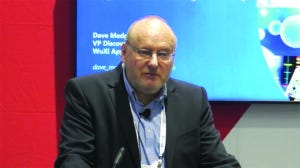- Sponsored Content
Building a Comprehensive Toolbox for Oligonucleotide Drug DiscoveryBuilding a Comprehensive Toolbox for Oligonucleotide Drug Discovery
August 24, 2022
Sponsored by WuXi AppTec
 Dave Madge, vice president, WuXi AppTec.
Dave Madge, vice president, WuXi AppTec.
Dave Madge oversees a number of WuXi AppTec’s preclinical discovery services from his base in Cambridge, UK. He spoke about his company’s capabilities in building new modalities, in particular for oligonucleotide therapeutics. Following an introduction on new modalities and oligonucleotides, he presented a workflow for discovery, chemistry, and biology for siRNA therapeutics, focusing on synthetic DNA and RNA therapeutics.
Two main factors contribute to the importance of alternative modalities. First, within the small-molecule and antibody-drug spaces, existing approved drugs modulate only about 0.1% of the human genome — creating an untapped therapeutic field. Second, the more that the industry learns about disease drivers and how to manipulate therapeutic processes, the more opportunities arise for interaction.
The industry is not currently engaging in the entire landscape of therapeutic possibilities — even among well-validated target classes. Beyond those targets are rare diseases, in which well over 6,000 proteins are associated with monogenetic disorders. That space requires alternatives to small-molecule therapeutics. Nucleic-acid therapeutics should enable companies to address alternative modes of action.
Madge described different advantages offered by synthetic oligonucleotide therapeutics for protein production and listed some of the oligonucleotide therapeutics in research, development, and on the market. This fast-moving area of study is attracting substantial amounts of investment with a number of late-stage clinical molecules moving through development. The many variations of oligonucleotide therapeutics require different strategies for selecting targets, synthesizing the molecules, optimizing them, and testing their in vitro and in vivo biology.
Small, interfering RNA molecules (siRNAs) are double strands of oligo RNA that match each other, with many variations of overlapping-strand topology. The mechanism of action is that the double-stranded siRNA engages with the machinery that is normally tasked with translating mRNA into protein. It effectively diverts that machinery so that the mRNA for a protein of interest ends up being tagged and degraded. Madge described the multiple levels of this technology and the enabling breakthrough of chemically modifying key parts of the molecules to increase their stability substantially. Doing so could enable human dosing over protracted periods. He outlined how some of the modifications can occur, noting that despite the substantial number of variations, well-worn pathways have been developed to help elucidate the correct starting points.
The molecules do not cross cell membranes naturally. So along with getting across membranes and to a site of action, they also need to be delivered only to the cells that are relevant for a therapeutic objective. They can be coupled with another element that helps to achieve both selectivity and delivery. Madge provided examples of that approach to conjugation as well as complexation into a larger lipid molecule that will recognize a particular cell type and deliver the oligo into that cell.
Madge highlighted the need to develop new ways of modeling molecules to understand not only their sequences, but also modifications thereof. He walked the audience through the process for assembling these molecules from an initial bioinformatics starting point and then through synthesis and into biological characterization.
His slides illustrated WuXi AppTec’s workflow for designing the antisense strand of an siRNA therapeutic and ways in which the company investigates off-target liabilities. He noted the importance of understanding the competitive intellectual property landscape during the early stage of selecting sequences for synthesis. Synthesizing those molecules is complex because they often contain large numbers of specialized monomers.
Madge next outlined a number of key steps in choosing conjugation methods with examples of the chemistry of galena conjugates. He detailed tasks for optimizing modification patterns, investigating stabilizing activities, characterizing new variations on the chemistry, and envisioning what they will do from a stability-enhancing or an efficacy-enhancing perspective. He spoke about how to characterize those molecules and detailed many other subsequent steps, including use of proliferation and cell-stability assays, use of assays for stability and for understanding pharmacokinetic and pharmacodynamic (PK/PD) relationships, and development of bioanalytical methods.
Fill out the form below to view the full BPI Theater presentation.
You May Also Like






